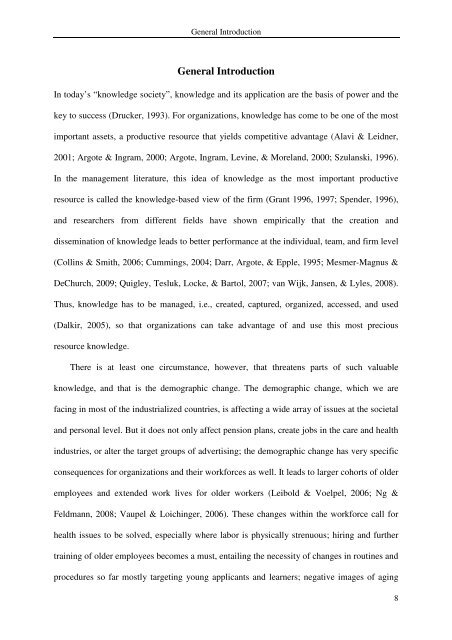thesis_Daniela Noethen_print final - Jacobs University
thesis_Daniela Noethen_print final - Jacobs University
thesis_Daniela Noethen_print final - Jacobs University
You also want an ePaper? Increase the reach of your titles
YUMPU automatically turns print PDFs into web optimized ePapers that Google loves.
General Introduction<br />
General Introduction<br />
In today’s “knowledge society”, knowledge and its application are the basis of power and the<br />
key to success (Drucker, 1993). For organizations, knowledge has come to be one of the most<br />
important assets, a productive resource that yields competitive advantage (Alavi & Leidner,<br />
2001; Argote & Ingram, 2000; Argote, Ingram, Levine, & Moreland, 2000; Szulanski, 1996).<br />
In the management literature, this idea of knowledge as the most important productive<br />
resource is called the knowledge-based view of the firm (Grant 1996, 1997; Spender, 1996),<br />
and researchers from different fields have shown empirically that the creation and<br />
dissemination of knowledge leads to better performance at the individual, team, and firm level<br />
(Collins & Smith, 2006; Cummings, 2004; Darr, Argote, & Epple, 1995; Mesmer-Magnus &<br />
DeChurch, 2009; Quigley, Tesluk, Locke, & Bartol, 2007; van Wijk, Jansen, & Lyles, 2008).<br />
Thus, knowledge has to be managed, i.e., created, captured, organized, accessed, and used<br />
(Dalkir, 2005), so that organizations can take advantage of and use this most precious<br />
resource knowledge.<br />
There is at least one circumstance, however, that threatens parts of such valuable<br />
knowledge, and that is the demographic change. The demographic change, which we are<br />
facing in most of the industrialized countries, is affecting a wide array of issues at the societal<br />
and personal level. But it does not only affect pension plans, create jobs in the care and health<br />
industries, or alter the target groups of advertising; the demographic change has very specific<br />
consequences for organizations and their workforces as well. It leads to larger cohorts of older<br />
employees and extended work lives for older workers (Leibold & Voelpel, 2006; Ng &<br />
Feldmann, 2008; Vaupel & Loichinger, 2006). These changes within the workforce call for<br />
health issues to be solved, especially where labor is physically strenuous; hiring and further<br />
training of older employees becomes a must, entailing the necessity of changes in routines and<br />
procedures so far mostly targeting young applicants and learners; negative images of aging<br />
8

















